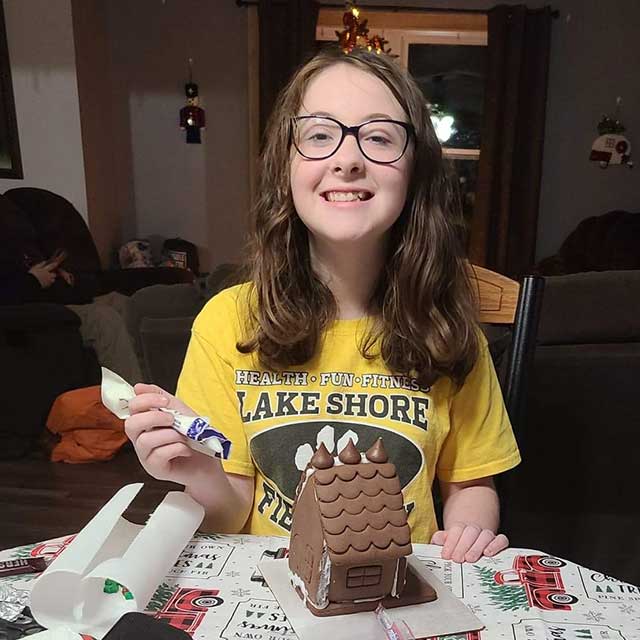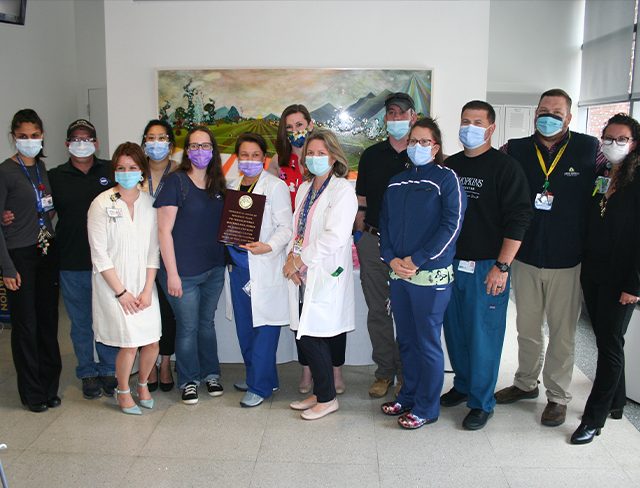In the wake of their 12-year-old child’s tragic death and her organ donations to other children, a family reaches out in unprecedented ways to the intensive care staff who cared for her.
By Gary Logan (Johns Hopkins Medicine, 6/21/2021)
At noon on June 2, a dozen selected staff members from the pediatric intensive care unit (PICU) at Johns Hopkins Children’s Center sat quietly in a conference room awaiting the start of a ceremony they knew nothing about. They only knew their presence was requested. Then Will Klaes and Kristine Welder quietly walked in and the PICU staff instantly connected with them. Their eyes locked in on the couple as they headed for the front of the room, where they placed a plaque on a table decorated with pink cupcakes and flowers. Some revealed smiles behind their masks, some started to tear up, some did both. Now they knew. They had to.
They were called to this room on this day because two months earlier they had cared for and fought for Klaes and Welder’s daughter, 12-year-old Makenzie, who, after 10 days on the unit, succumbed to the severe head trauma she suffered in a motor vehicle accident. They remembered her parents well: the stories they shared about their daughter and her infectious attitude of thinking about others first and giving to others first, her love of animals and the color pink, her dream of becoming a marine biologist one day. They recalled the parents’ patience and realistic understanding that their child likely would not survive, and, perhaps most of all, the immense gratitude they showed for the staff’s efforts to save their daughter. They knew firsthand that the family chose to donate Makenzie’s organs — her heart, both lungs, pancreas and intestines, and both kidneys — which saved six other lives, including two teens like her. These parents had done so much in the face of their child’s suffering and in the wake of her death — so why were they here now?

Makenzie’s heart saved the life of a teenager, her right kidney the life of another teen, her left kidney and lungs two people in their 40s, and her pancreas, intestines and liver two people in their 30s. Living Legacy is one of 57 organ procurement organizations in the United States. The donor services area for Living Legacy is most of the state of Maryland, and includes 33 hospitals.

The message on the plaque, read by Makenzie’s father to the assembled group, told the heart of the story: “This plaque is ‘Presented in honor of Makenzie Klaes to the incredible doctors and nurses of Johns Hopkins Children’s Center in grateful recognition of all of your hard work.’” He added, “We’ve seen that it’s not just a job for you guys here — you all genuinely care. This gift is not our gift, it’s what Makenzie would want to do.”
The family was taking another step in giving back, showing gratitude in a public way, even in the face of the tragic loss of their Makenzie. While the PICU staff has received countless expressions of appreciation from families for their efforts over the years, regardless of the outcome, this response was startling in ways, unprecedented.
“The bravery, the strength for a parent to come back into the hospital where their child died and suffered is unimaginable,” says Jamie McElrath Schwartz, division chief of pediatric critical care medicine. “Most parents are intensely grateful for what we do, and will say the same words these parents said, but it’s unusual, unprecedented really, for parents then to act on it in this way, to come back and do something to honor us. That is extraordinary.”
“Occasionally families visit our unit, which is always very meaningful for us,” says pediatric intensivist Caitlin O’Brien. “In some way it helps us with our grieving, as well. With Makenzie, she gave us hope in that she went on to change the lives of six people.”
“Makenzie’s personality shone bright through her family,” says critical care nurse Taylor George. “That they came back to honor us as her medical team just shows how big their hearts are.”
“I am continually impressed by families that put aside their own grief and think of others in some of the worst days of their lives,” adds Anna Noguchi, coordinator for organ and tissue donation at Johns Hopkins and a former intensive care nurse very familiar with end-of-life situations. “Especially in this case with Makenzie, I heard her dad say multiple times how caring and giving of a person she is, and for them it was an easy decision. She had a light that drew people in.”
Susanna Scafidi said to the parents at the ceremony. “While I got to go home and take a shower, you were there no matter what time I left and came back. You were understanding no matter what kind of information we dumped on you. Thank you for this gift. To keep us with you and Mackenzie throughout this journey.”
The journey began on March 15, when Makenzie arrived in the PICU from the trauma bay. Critical care specialist Corina Noje was among the first in the unit to assess her extensive neurologic injuries. Pediatric trauma and neurosurgical services were already involved, Noje learned as she read the results of the girl’s initial brains scans, activated a massive transfusion protocol and began monitoring the pressure in Makenzie’s brain. She was focused, but saddened by what she was seeing.
Resuscitation continued throughout the night but to no avail. In the coming days, the intensivists and critical care nurses Natali Jimenez, Patricia Massaro, Julie Nightwine and Rebecca Veltri, among others, continued to care for Makenzie, hoping for a turnaround. Additional imaging and two brain-death exams, however, would confirm that Makenzie had ceased to have functioning brain activity. The team decided it was time to give the family their final finding.
“Sometimes you don’t know how to best help a lovely and grateful family like this,” says Noje. “You feel so bad to give bad news over bad news.”
It’s an extremely sensitive and vulnerable time for the family and staff — a time in which emotional currents run deep, the intensivists explain. In western medicine clinicians do everything possible to ensure the best chance for survival, and then the direction the patient takes does not align with the family’s hopes.
“It’s high stress for the family, the worse day of their lives, and also for that medical team caring for the family,” says Noguchi. “I worked with adult patients on the medical ICU, and it’s different here — kids aren’t supposed to die. I understand how difficult and emotionally triggering it can be, how it can pull you in a lot of different directions.”
It did. But staff knew the family was realistic about Makenzie’s prognosis, which made it easier, if that word can be used, to support the family and to bring up issues like organ donation. As it turned out, they did not have to — the parents had already explored naming Makenzie an organ donor. Again, they said, it was what Makenzie would want to do.
“The family was very interested in Makenzie being a donor and part of her continuing to live in others,” says Noje.
Now the staff support continued but in a different way.
“During the time Makenzie was alive in the PICU, we were connected and able to understand the family, their daughter, their values,” says Schwartz. “We bonded together as a therapeutic team to save her life, and when we couldn’t save her life, we supported her family when she was able to be an organ donor. Her death would have additional dignity and meaning for others.”
Noguchi was now the point person for the family in coordinating the organ donor process with The Living Legacy Foundation of Maryland until Makenzie’s final visit to the operating room for recovery of her organs for transplant. Makenzie’s parents and other family members followed her down an OR corridor lined on both sides with PICU staff — the “honor guard” they traditionally form when an organ donor patient leaves the unit. In this instance, the patient left the unit with pink hair, thanks to members of the PICU’s palliative care and Child Life teams, who learned about Makenzie’s repeated requests to dye her hair pink.
“They worked very hard to restore a little bit of Makenzie’s spirit when it was clear she was not going to survive,” says Noguchi. “Also, when Makenzie’s name plaque is placed on the donor wall in the hospital, it too will be pink.”
Looking back at the June 2 ceremony, some of the PICU staff members met to discuss the looking back at the family’s experience and response. “It’s hard to put it into boxes; we haven’t had this type of family reaction before,” says Noje. “Some folks felt not worthy of the appreciation, although there was nothing else we could have possibly done for Makenzie. Some felt that maybe if the roles were reversed they could never react like that with love and gratitude to this horrendous tragedy.
“If ever faced with a similar scenario, I can only hope to handle it as gracefully as Makenzie’s family,” says Massaro. “I am overwhelmingly impressed and grateful that they were able to return to the hospital to share their words and gestures of thanks and appreciation.”
Noje adds, “We generally felt maybe this is something that helps us in the medical field to get up and do this again day after day knowing ultimately there is appreciation in life and in death. Everyone, all in all, agreed the family’s response helped them cope with Makenzie’s passing and this nonsensical tragedy, and to move on to the next chapter in their lives that will never be the same. That’s how we thought of it.”